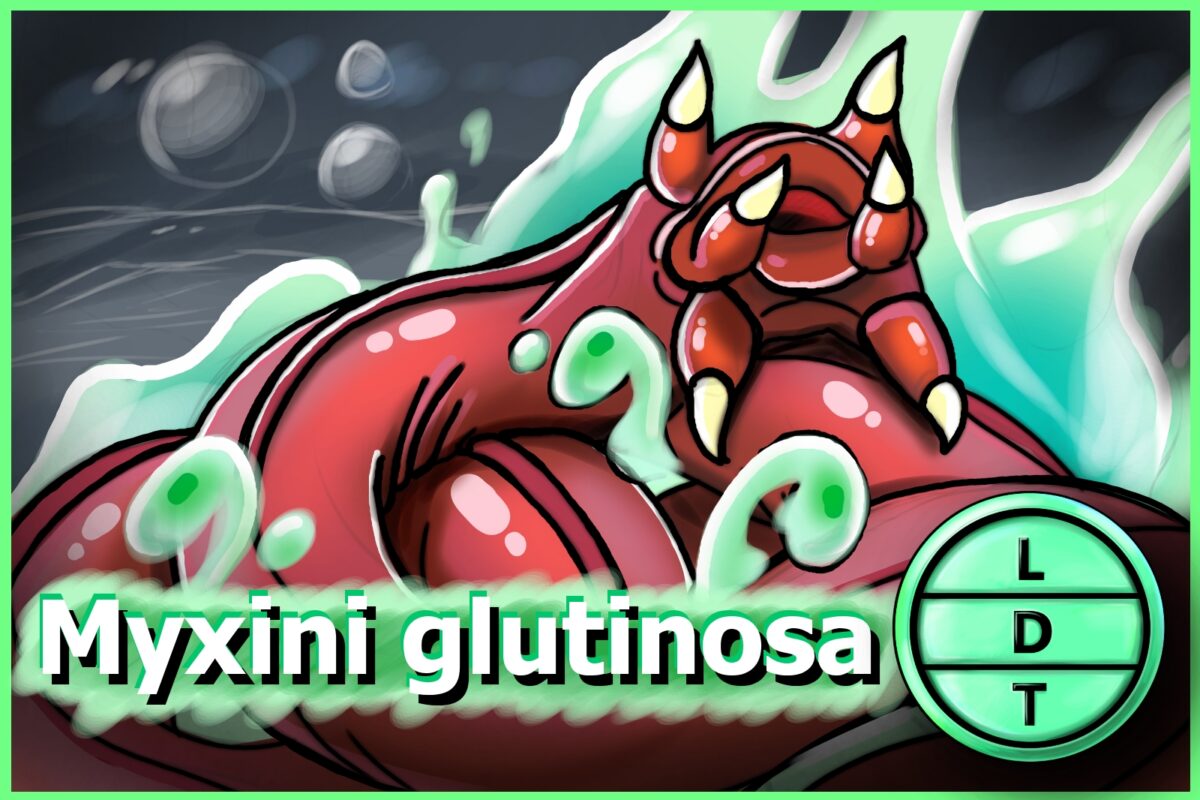“…And today we’re talking about a sea noodle that’s as disgusting as we’ve come to expect from the bottom of the ocean.”
Imagine you’re a big fish with a hankering for some ocean detritus. You find a carcass that’s descended to the seafloor, but you’re late to the party. It’s surrounded by a nightmare mob of tangled noodles making quick work of the body. But no matter, you’ll just take one of these noodles for your supper. But it’s not a noodle. It’s a pacific hagfish, and with your first bite, you know you’ve made a huge mistake. But surprising defensive tactics are essential in the sea, especially if you seek success in Life, Death, and Taxonomy.
Description of the Pacific Hagfish
- Basically an eel/worm/snake with a wide, flat tail.
- They are actually cartilaginous fish (like sharks) and have a skeleton that is comprised of a skull and nothing else.
- Pacific hagfish are actually the only animals that have a skull and no spine. Though apparently, it has “rudimentary vertebrae”, which is why it’s still in the phylum Chordata, though that’s up for debate.
- While it has a skull, the pacific hagfish doesn’t have a jaw. Instead, they have four teeth attached to ligaments that they can pull food into their mouths with.
- It also has a pair of basic eyespots that can perceive light rather than eyes that can see images (you don’t really need to see much when you’re 3K feet below the surface.
Measure Up
Welcome to the beloved Measure Up segment. The official listener’s favorite part of the show! The part of the show when we present the animal’s size and dimension in relatable terms through a quiz that’s fun for the whole family. It’s also the part of the show that’s introduced by you when you send in audio of yourself saying, singing, or chittering the words measure up into ldtaxonomy at gmail dot com.
Length
- 63 cm (25 in)
- How many Declarations of Independence go into the length of a hagfish?
- Hint: The declaration was written by Thomas Jefferson, but it was the work of the Committee of Five which also included John Adams, Ben Franklin, Roger Sherman, and Robert Livingston.
- 1.2. The declaration is 30 x 24.
Weight
- 3 lb (1.4kg)
- How many hagfish go into the weight of a gallon of water?
- Hint: Water is commonly used to weight things, including certain types of medicine balls.
- 2.7 hagfish.
Fast Facts About the Hagfish
- Range: The absolute bottom of the Pacific Ocean, in some of the deepest places on Earth. Specifically, this slimy boy lives in the Eastern portion of the Pacific, so along North America’s coast.
- Diet: They mainly eat bristle worms at the bottom of the ocean. But they also are opportunistic scavengers that will slip into dead fish or animals whose bodies fell to the ocean floor and eat them.
- They can survive for months without food since their metabolism is so low.
- They’ll actually tear apart the catch of deep-sea fishermen before they can drag their nets back up.
- Behavior: There are actually far more females than males in many hagfish species. Some species have a 100:1 ratio of females to males. But there is some evidence that they can be hermaphroditic like some gastropods.
- It’s tough to study these guys in captivity since they don’t do well outside of the crushing pressure of Davy Jones locker.
Major Fact: It’s Sticky! What is it!?
The Pacific hagfish has several interesting facts that could be considered major. Its horrifying maw is one of them. But, as with many creatures, the true oddity lies not in its offense but its defense.
The hagfish is covered in tiny little pores like portholes on a submarine. From these holes, emerges a thick mucus slime. The hagfish releases this slime when it’s threatened or agitated, and especially when it seems like it might become lunch. When it’s threatened, it can instantly release copious amounts of the viscous substance. In minutes, even a small hagfish can fill your standard Home Depot bucket.
They do this by releasing proteins that coat their bodies in slime when they come into contact with water. They also expand into a huge slime cloud around them.
There’s a video of this occurring where researchers place bait and a camera in hagfish territory. The hagfish come in for a snack and sharks and eels come to snack on the hagfish. One exploratory bite causes the predator to recoils, dropping the fish and leaving.
The slime isn’t noxious or poisonous, but it’s detested by predators. A predator with a mouth full of slime can have its throat or gills clogged by the viscous liquid. The slime is clingy, and fishermen loathe to have it attached to gear. So it’s not something you want in your gills.
Ending: So work under pressure, keep your eyespots peeled, and use slime to your advantage like you just won a Kid’s Choice Award like the hagfish here in LDT.

